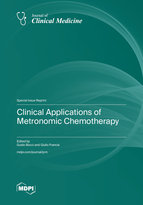Clinical Applications of Metronomic Chemotherapy
A special issue of Journal of Clinical Medicine (ISSN 2077-0383). This special issue belongs to the section "Oncology".
Deadline for manuscript submissions: closed (25 April 2022) | Viewed by 22147
Special Issue Editors
Interests: metronomic chemotherapy; pharmacokinetics; pharmacodynamics; clinical trials
Special Issues, Collections and Topics in MDPI journals
Interests: chemotherapy; cancer biology; metronomic chemotherapy; metastasis; immunotherapy
Special Issues, Collections and Topics in MDPI journals
Special Issue Information
Dear Colleagues,
Metronomic chemotherapy has finally arrived in clinical use. After 20 years of preclinical development and clinical trials, the emerging data will be of paramount importance in allowing us to assess the impact of metronomic chemotherapy on different tumor types. Indeed, it is likely that the next decade will see a major reassessment of the possible applications of metronomic chemotherapy, alone and in combination with new therapeutic approaches such as immunotherapies, for the management of cancer. Moreover, the clinical trial results will likely profoundly affect the direction of the laboratory efforts that are going on in parallel, aimed at improving personalization of this therapeutic strategy. This Special Issue is our attempt to cover the past and present clinical results that have brought us to this pivotal moment and build the bases for future clinical developments. Scientists and clinicians caring for cancer patients are well aware of the challenges in dealing with this particular therapeutic approach, such as to obtain an improvement of patient survival without an important toxicity. The expectation today is that this different approach to clinical research on chemotherapy will translate into genuine progress in routine therapy. With this Special Issue, we hope to encourage submissions that discuss the current state-of-the-art, address ongoing knowledge gaps, and focus on ongoing controversies related to metronomic chemotherapy.
Dr. Guido Bocci
Prof. Giulio Francia
Guest Editors
Manuscript Submission Information
Manuscripts should be submitted online at www.mdpi.com by registering and logging in to this website. Once you are registered, click here to go to the submission form. Manuscripts can be submitted until the deadline. All submissions that pass pre-check are peer-reviewed. Accepted papers will be published continuously in the journal (as soon as accepted) and will be listed together on the special issue website. Research articles, review articles as well as short communications are invited. For planned papers, a title and short abstract (about 100 words) can be sent to the Editorial Office for announcement on this website.
Submitted manuscripts should not have been published previously, nor be under consideration for publication elsewhere (except conference proceedings papers). All manuscripts are thoroughly refereed through a single-blind peer-review process. A guide for authors and other relevant information for submission of manuscripts is available on the Instructions for Authors page. Journal of Clinical Medicine is an international peer-reviewed open access semimonthly journal published by MDPI.
Please visit the Instructions for Authors page before submitting a manuscript. The Article Processing Charge (APC) for publication in this open access journal is 2600 CHF (Swiss Francs). Submitted papers should be well formatted and use good English. Authors may use MDPI's English editing service prior to publication or during author revisions.
Keywords
- Metronomic chemotherapy
- Lymphoma
- Gastrointestinal cancers
- Breast cancer
- Lung cancer
- Prostate cancer
- Pediatric tumors








